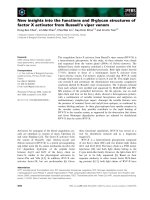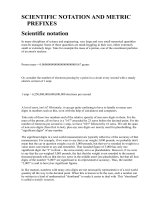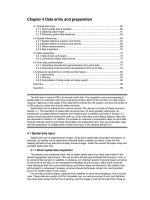Chapter 4 thermodynamic functions and fundamental equations
Bạn đang xem bản rút gọn của tài liệu. Xem và tải ngay bản đầy đủ của tài liệu tại đây (720.44 KB, 34 trang )
PHYSICAL CHEMISTRY 1
Chapter 4 – Thermodynamic functions and
Fundamental equations
Ngo Thanh An
Part 1 – Thermodynamic functions
Thermodynamic functions
Thermodynamic function
Symbol
Definition
unit
Gibbs free energy (isothermal, isobaric
thermodynamic potential)
G
G = H –TS
Cal or
J
Helmholtz free energy (isothermal,
isochoric thermodynamic potential)
F
F = U – TS
Cal or
J
Entropy
S
dS=Qrev/T
cal.K–1
J.K–1
Internal energy
U
Enthalpy
H
Cal or J
H = U + PV
Cal or J
3
Thermodynamic functions
�
U�
�
T � �
��S �
V
U�
��
H U PV U V � �
V�
��
S
�
U�
�
P � �
��V �
S
U � ��
U�
��
G H TS U V � � S� �
V�
S�
��
��
S
V
��2U �
�
U�
�
CV � � � 2 � F U TS U S� �
��S �
V
��S �
��S �
V
V
��U �
4
Characteristics of thermodynamic functions
•
•
•
•
•
Internal energy U: minimum at a given S, V.
Entropy S: maximum at a given U, V.
Gibbs function G: minimum at a given T, P.
Helmholtz function F: minimum at a given T, V.
Enthalpy H: minimum at a given S, P.
Characteristics of thermodynamic functions
Characteristics of thermodynamic functions
Chứng minh
Theo nguyên lý tăng entropy, khi entropy đạt cực đại thì:
Ta đặt giá trị A bằng:
Vậy A sẽ bằng:
Ta lại có:
Áp dụng công thức:
Characteristics of thermodynamic functions
Chứng minh
Vậy giá trị A cũng sẽ bằng 0, tức là U cũng sẽ đạt cực trị theo V tại 1 giá trị entropy
nào đó. Ta xem A là một hàm số của A = A(V, U(V)). Tính chất đạo hàm của hàm hợp
cho ta công thức:
Như vậy, ta sẽ có:
Với điều kiện A = 0, sẽ cho ta:
Characteristics of thermodynamic functions
Chứng minh
Như vậy, hàm U sẽ đạt cực tiểu
Relations of thermodynamic functions
Legendre transform
If we have a function F = F(x,y)
We need to transform function F(x,y) into:
Function G(x,w) where w is a conjugate variable of variable y.
Function H(u,y) where u is a conjugate variable of variable x.
Function L(u,w) where u, w are conjugate variables of x, y respectively.
Prove:
where:
(1)
(2)
Equation (1) – equation (2), having :
Where
Relations of thermodynamic functions
Legendre transform
Therefore
where:
In summary, Legendre transform is a method to converse a function F(x,y) into a
new function G(x,w), where y and w are a couple of conjugate variable.
Relations of thermodynamic functions
Application of Legendre transform
H
From function U = U(S, V), we
can transform to different state
functions as follows:
• H(S, P) = U(S, V) + PV
• F(T, V) = U(S, V) – TS
• G(T, P) = U(S, V) – TS + PV
U
TS
TS
PV
F
PV
G
Relations of thermodynamic functions
Relationship between state function and
state variable
U = f(V, S)
F = f(V, T)
H = f(P, S)
G = f(P, T)
Due to state function, we have total differential:
G�
G�
��
��
Ex: G = f(P,T), dG = �
�dP � �dT
P�
T�
��
��
T
P
Relations of thermodynamic functions
Josiah Willard Gibbs
Hermann von Helmholtz
Relations of thermodynamic functions
Applications of thermodynamic functions
First order differential
•
Relations of thermodynamic functions
Applications of thermodynamic functions
Second order differential
Relations of thermodynamic functions
Maxwell relations
Mụcđíchápdụngcácphươngtrìnhnàylàđểcóthểtín
htoánđượccácthôngsốnhiệtđộngkhócóthểxácđịn
hđượctrongthựcnghiệm.
(1)
(2)
(3)
(4)
Relations of thermodynamic functions
Maxwell relations
Chứng
• minh cácphươngtrìnhnàynhưthếnào?
• Phươngtrìnhliênhệ Euler:
Nếu Z làmộthàmsốtheo x, y, ta có z = f(x,y)
Khiđó vi toànphầncủa z sẽlà:
Ta lạicó:
Nhưvậy, ta có: (nếu )
Relations of thermodynamic functions
Maxwell relations
a.
Gibbs
• Trongtrườnghợpápdụngphươngtrình
chonộinăng U:
• Ta sẽcó:
b. Trongtrườnghợpápdụngphươngtrình Gibbs cho
enthalpy:
• Ta sẽcó:
Relations of thermodynamic functions
Maxwell relations
c.
Gibbs
• Trongtrườnghợpápdụngphươngtrình
chohàm F:
• Ta sẽcó:
d. Trongtrườnghợpápdụngphươngtrình Gibbs
chohàm G:
• Ta sẽcó:
Effect of thermodynamic properties
Summary
Effect of thermodynamic properties
Internal Energy Changes
22
Effect of thermodynamic properties
23
Effect of thermodynamic properties
Enthalpy Changes
24
25









